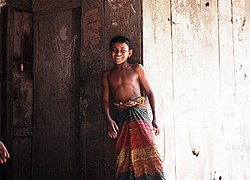
A draped garment is a garment that is made of a single piece of cloth that is draped around the body; drapes are not cut away or stitched as in a tailored garment. Drapes can be held to the body by means of knotting, pinning, fibulae, clasps, sashes, belts, tying drawstrings, or just plain friction and gravity alone. Many draped garments consist of only one single piece.

A loincloth is a one-piece garment, either wrapped around itself or kept in place by a belt. It covers the genitals and sometimes the buttocks. Loincloths which are held up by belts or strings are specifically known as breechcloth or breechclout. Often, the flaps hang down in front and back.
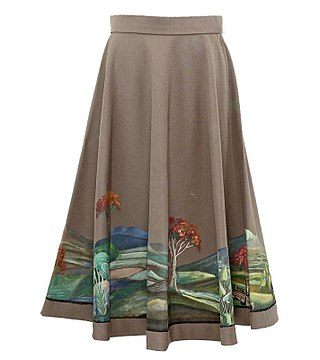
A skirt is the lower part of a dress or a separate outer garment that covers a person from the waist downwards.
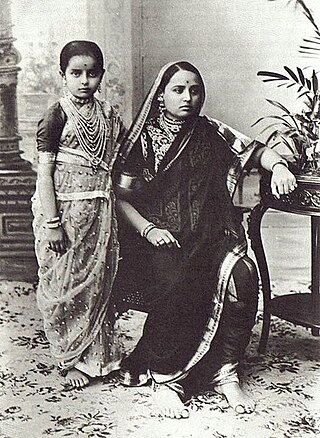
A sari is a women's garment from the Indian subcontinent, that consists of an un-stitched stretch of woven fabric arranged over the body as a robe, with one end attached to the waist, while the other end rests over one shoulder as a stole (shawl), sometimes baring a part of the midriff. It may vary from 4.1 to 8.2 metres in length, and 60 to 120 centimetres in breadth, and is a form of ethnic wear in India, Sri Lanka, Nepal, Bangladesh and Pakistan. There are various names and styles of sari manufacture and draping, the most common being the Nivi style. The sari is worn with a fitted bodice also called a choli and a petticoat called ghagra, parkar, or ul-pavadai. It remains fashionable in the Indian subcontinent today.

A kurta is a loose collarless shirt or tunic worn in many regions of South Asia, and now also worn around the world. Tracing its roots to Central Asian nomadic tunics, or upper body garments, of the late-ancient- or early-medieval era, the kurta has evolved stylistically over the centuries, especially in South Asia, as a garment for everyday wear as well as for formal occasions.

The dhoti, also known as veshti, mardani, dhotar, jaiñboh or panchey, is a garment worn around the waist and fastened between the legs to resemble trousers. It is usually worn loose. It is most popular in India and Nepal. The dhoti is a lower garment forming part of ethnic wear for men in the Indian subcontinent. The dhoti is fashioned out of a rectangular piece of unstitched cloth, usually around 4.5 metres (15 ft) long, wrapped around the waist and the legs and knotted, either in the front or the back.

A sarong or a sarung is a large tube or length of fabric, often wrapped around the waist, worn in Southeast Asia, South Asia, Western Asia, Northern Africa, East Africa, West Africa, and on many Pacific islands. The fabric often employs woven plaid or checkered patterns or may be brightly colored by means of batik or ikat dyeing. Many modern sarongs have printed designs, often depicting animals or plants. Different types of sarongs are worn in different places in the world, notably the lungi in the Indian subcontinent and the izaar in the Arabian Peninsula.
Clothing in India varies with the different ethnicities, geography, climate, and cultural traditions of the people of each region of India. Historically, clothing has evolved from simple garments like kaupina, langota, achkan, lungi, sari, to rituals and dance performances. In urban areas, western clothing is common and uniformly worn by people of all social levels. India also has a great diversity in terms of weaves, fibers, colors, and the material of clothing. Sometimes, color codes are followed in clothing based on the religion and ritual concerned. The clothing in India also encompasses a wide variety of Indian embroidery, prints, handwork, embellishments, and styles of wearing clothes. A wide mix of Indian traditional clothing and western styles can be seen in India.

The mundu is a garment worn around the waist in the Indian states of Kerala, Tamil Nadu, the Lakshadweep archipelago, and the Indian Ocean island nation of Maldives. It is closely related to sarongs like dhotis and lungis. It is normally woven in cotton and coloured white or cream. The colour is dependent on whether the cotton is bleached or unbleached. A khadaṟ muṇṭŭ is made using handlooms. When unbleached, the mundu is called nēriyatu. In modern times, two types of mundu are prevalent—the single and the double. A single mundu is wrapped only once around the waist, while the double one is folded in half before wearing. A mundu is usually starched before use.

The malong is a traditional Filipino-Bangsamoro rectangular or tube-like wraparound skirt bearing a variety of geometric or okir designs. The malong is traditionally used as a garment by both men and women of the numerous ethnic groups in the mainland Mindanao and parts of the Sulu Archipelago. They are wrapped around at waist or chest-height and secured by tucked ends, with belts of braided material or other pieces of cloth, or are knotted over one shoulder. They were traditionally hand-woven, with the patterns usually distinctive to a particular ethnic group. However, modern malong are usually machine-made or even imported, with patterns that mimic the traditional local designs.

A longyi is a sheet of cloth widely worn in Myanmar (Burma). It is approximately 2 metres (6.6 ft) long and 80 centimetres (2.6 ft) wide. The cloth is often sewn into a cylindrical shape. It is worn around the waist, running to the feet, and held in place by folding fabric over without a knot. In ancient times, Lethwei fighters would hitch it up to compete. This folding technique is still being used in modern days when people play chinlone.
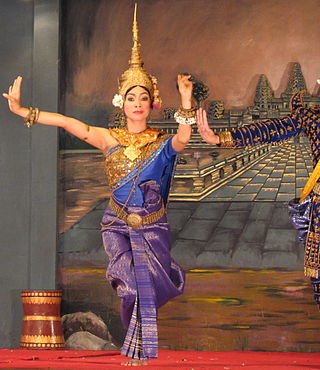
A sampot, a long, rectangular cloth worn around the lower body, is a traditional dress in Cambodia. It can be draped and folded in several different ways. The traditional dress is similar to the dhoti of Southern Asia. It is also worn in the neighboring countries of Laos and Thailand where it is known as pha nung.

Outside Western cultures, men's clothing commonly includes skirts and skirt-like garments; however, in the Americas and much of Europe, skirts are usually seen as feminine clothing and socially stigmatized for men and boys to wear, despite having done so for centuries. While there are exceptions, most notably the cassock and the kilt, these are not really considered 'skirts' in the typical sense of fashion wear; rather they are worn as cultural and vocational garments. People have variously attempted to promote the fashionable wearing of skirts by men in Western culture and to do away with this gender distinction.

Khmer traditional clothing refers to the traditional styles of dress worn by the Khmer people throughout history. Tracing their origins back to the early Common Era, the customary styles of dress worn by Khmer people predate the indianization of Southeast Asia. The evolution of these clothing customs can be traced through archaeological artifacts from the 6th century to the post-Angkorian period, evolving from the simple pre-Angkorian Sampot to vibrant and intricately embroidered silk garments. Khmer traditional costumes are nowadays mainly worn for celebrations, reflecting a strong sense of national identity.

The kaupinam, kaupina, langot, or lungooty is a loincloth worn by men in the Indian subcontinent as underclothing. It is still commonly worn in South Asia by pehlwans (wrestlers) while exercising or sparring in a dangal. It is basically a rectangular strip of cloth used to cover the genitals, with strings connected to the four ends of the cloth, for binding it around the waist and between the legs.
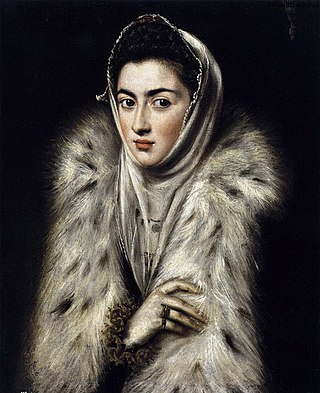
In the context of clothing, a wrap can refer to a shawl or stole or other fabric wrapped about the upper body, or a simple skirt-type garment made by wrapping a piece of material round the lower body. Many people of all genders throughout the world wear wraps in everyday life, although in the West they are largely worn by women. They are sometimes sewn at the edges to form a tube which keeps the required size. A wrap may be secured by a corner being tucked beneath the wrapped material, by making a knot, or using ties, buttons or velcro.

The national costume of Indonesia is the national attire that represents the Republic of Indonesia. It is derived from Indonesian culture and Indonesian traditional textile traditions. Today the most widely recognized Indonesian national attires include batik and kebaya, although originally those attires mainly belong within the island of Java and Bali, most prominently within Javanese, Sundanese and Balinese culture. Since Java has been the political and population center of Indonesia, folk attire from the island has become elevated into national status.

History of clothing in the Indian subcontinent can be traced to the Indus Valley civilization or earlier. Indians have mainly worn clothing made up of locally grown cotton. India was one of the first places where cotton was cultivated and used even as early as 2500 BCE during the Harappan era. The remnants of the ancient Indian clothing can be found in the figurines discovered from the sites near the Indus Valley civilisation, the rock-cut sculptures, the cave paintings, and human art forms found in temples and monuments. These scriptures view the figures of human wearing clothes which can be wrapped around the body. Taking the instances of the sari to that of turban and the dhoti, the traditional Indian wears were mostly tied around the body in various ways.
Clothing in Myanmar varies depending on the ethnicity, geography, climate and cultural traditions of the people of each region of Myanmar (Burma). The most widely recognized Burmese national costume is the longyi, which is worn by both males and females nationwide. Burmese clothing also features great diversity in terms of textiles, weaves, fibers, colours and materials, including velvet, silk, lace, muslin, and cotton.

A veshti, also known as vēṭṭi, is a white unstitched cloth wrap for the lower body in Tamil Nadu and in the North and East of Sri Lanka. Vēṭṭi is a part of the traditional attire consisting of Kurta and Angvastra. The garment is a single piece of cloth and similar to the dhoti, one of the earliest draped garments of India. A vēṭṭi is often layered with horizontal stripes or borders across its length.
